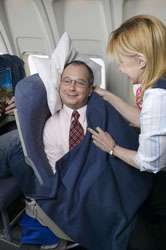Research: Decreasing cabin noise and vibration

Passenger comfort within the cabin is critical to maintenance of a competitive position. EU-funded researchers modified patented vibration-damping technology for use in aircraft.
Growing use of smaller turbofan or turboprop (propeller) aircraft for business jets or civil transport requires better cabin insulation from external vibrations, acoustic and thermal disturbances.
Patented ARTEC vibration-damping technology (SPADD, or Smart Passive Damping Device) significantly reduced vibration and noise in thin-shelled structures but was not appropriate for aerospace use.
European researchers with coordinator ARTEC Aerospace initiated the 'High performance damping technology for aircraft cabin vibration attenuation and thermo-phonic insulation' (ATPI) project to modify ARTEC technology for suitability in aircraft 'skins' and frames.
Air flow was identified as the main contributor to turbofan (flow turbulence) and turboprop (propeller-induced) noise and vibration. ATPI scientists set out to develop SPADD-skin technology to minimise flow-turbulence noise and SPADD-frame technology to minimise propeller-related noise.
Following characterisation of over 40 materials, the consortium produced prototypes of 6 different SPADD-skin treatments and 1 SPADD-frame.
Both the SPADD-skin configuration with glass wool blankets and the SPADD-frame exceeded technical objectives in terms of vibration and noise reduction. The latter also had 40 % less mass than the standard damped dynamic vibration absorber (DVA) solution, critical to the airline industry where increased weight means more fuel which translates to higher operating expenses.
Following the final phase of the ATPI project, a variety of SPADD-skin products were available for prototype manufacturing and testing.
ATPI delivered new technology for vibration and noise attenuation for aircraft cabin comfort while validating numerical methods for vibration damping assessment. Application should enhance the competitive position of European turbofan and turboprop manufacturers as well as of the airlines using their products.
Provided by CORDIS

















